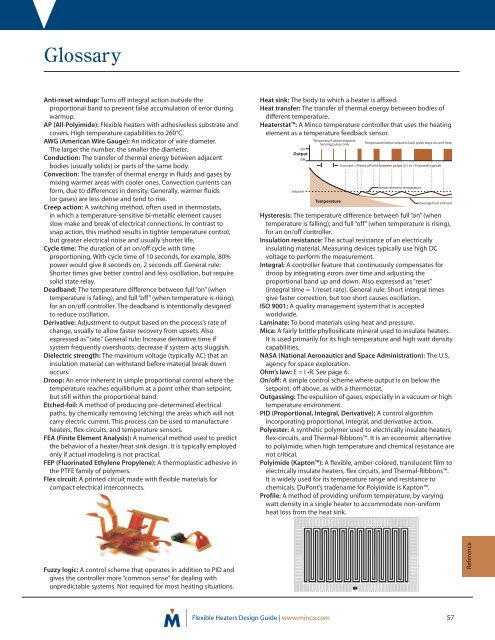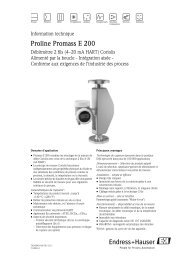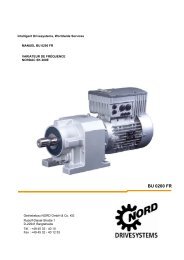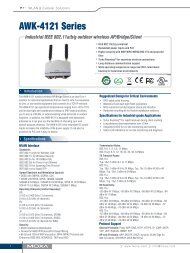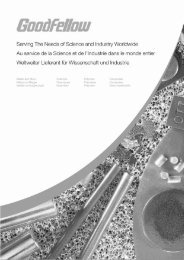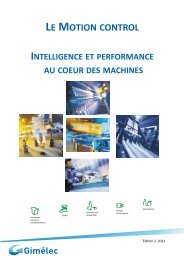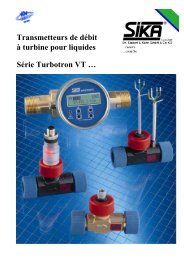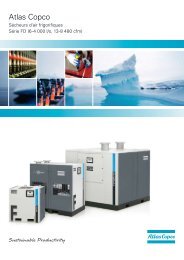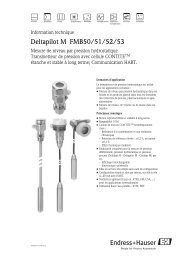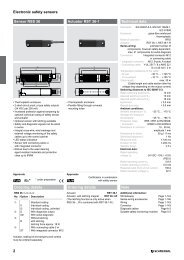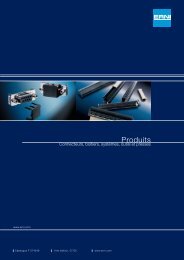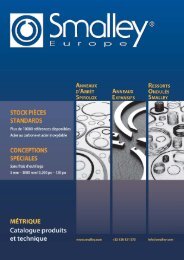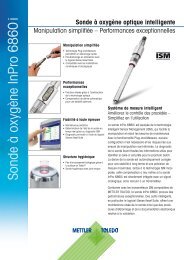Flexible Heaters Design Guide - BiS Sistem
Flexible Heaters Design Guide - BiS Sistem
Flexible Heaters Design Guide - BiS Sistem
Create successful ePaper yourself
Turn your PDF publications into a flip-book with our unique Google optimized e-Paper software.
Glossary<br />
Anti-reset windup: Turns off integral action outside the<br />
proportional band to prevent false accumulation of error during<br />
warmup.<br />
AP (All-Polyimide): <strong>Flexible</strong> heaters with adhesiveless substrate and<br />
covers. High temperature capabilities to 260°C.<br />
AWG (American Wire Gauge): An indicator of wire diameter.<br />
The larger the number, the smaller the diameter.<br />
Conduction: The transfer of thermal energy between adjacent<br />
bodies (usually solids) or parts of the same body.<br />
Convection: The transfer of thermal energy in fluids and gases by<br />
mixing warmer areas with cooler ones. Convection currents can<br />
form, due to differences in density. Generally, warmer fluids<br />
(or gases) are less dense and tend to rise.<br />
Creep action: A switching method, often used in thermostats,<br />
in which a temperature-sensitive bi-metallic element causes<br />
slow make and break of electrical connections. In contrast to<br />
snap action, this method results in tighter temperature control,<br />
but greater electrical noise and usually shorter life.<br />
Cycle time: The duration of an on/off cycle with time<br />
proportioning. With cycle time of 10 seconds, for example, 80%<br />
power would give 8 seconds on, 2 seconds off. General rule:<br />
Shorter times give better control and less oscillation, but require<br />
solid state relay.<br />
Deadband: The temperature difference between full “on” (when<br />
temperature is falling), and full “off” (when temperature is rising),<br />
for an on/off controller. The deadband is intentionally designed<br />
to reduce oscillation.<br />
Derivative: Adjustment to output based on the process’s rate of<br />
change, usually to allow faster recovery from upsets. Also<br />
expressed as “rate.” General rule: Increase derivative time if<br />
system frequently overshoots; decrease if system acts sluggish.<br />
Dielectric strength: The maximum voltage (typically AC) that an<br />
insulation material can withstand before material break down<br />
occurs.<br />
Droop: An error inherent in simple proportional control where the<br />
temperature reaches equilibrium at a point other than setpoint,<br />
but still within the proportional band.<br />
Etched-foil: A method of producing pre-determined electrical<br />
paths, by chemically removing (etching) the areas which will not<br />
carry electric current. This process can be used to manufacture<br />
heaters, flex-circuits, and temperature sensors.<br />
FEA (Finite Element Analysis): A numerical method used to predict<br />
the behavior of a heater/heat sink design. It is typically employed<br />
only if actual modeling is not practical.<br />
FEP (Fluorinated Ethylene Propylene): A thermoplastic adhesive in<br />
the PTFE family of polymers.<br />
Flex circuit: A printed circuit made with flexible materials for<br />
compact electrical interconnects.<br />
Heat sink: The body to which a heater is affixed.<br />
Heat transfer: The transfer of thermal energy between bodies of<br />
different temperature.<br />
<strong>Heaters</strong>tat: A Minco temperature controller that uses the heating<br />
element as a temperature feedback sensor.<br />
On<br />
Output<br />
Off<br />
Setpoint<br />
Temperature above setpoint:<br />
Sensing pulses only<br />
Temperature<br />
Temperature below setpoint: Each pulse stays on until heat<br />
Scan rate = Preset off time between pulses (0.1 to 10 seconds typical)<br />
Heater element temperature<br />
Average heat sink tem<br />
Hysteresis: The temperature difference between full “on” (when<br />
temperature is falling), and full “off” (when temperature is rising),<br />
for an on/off controller.<br />
Insulation resistance: The actual resistance of an electrically<br />
insulating material. Measuring devices typically use high DC<br />
voltage to perform the measurement.<br />
Integral: A controller feature that continuously compensates for<br />
droop by integrating errors over time and adjusting the<br />
proportional band up and down. Also expressed as “reset”<br />
(integral time = 1/reset rate). General rule: Short integral times<br />
give faster correction, but too short causes oscillation.<br />
ISO 9001: A quality management system that is accepted<br />
worldwide.<br />
Laminate: To bond materials using heat and pressure.<br />
Mica: A fairly brittle phyllosilicate mineral used to insulate heaters.<br />
It is used primarily for its high temperature and high watt density<br />
capabilities.<br />
NASA (National Aeronautics and Space Administration): The U.S.<br />
agency for space exploration.<br />
Ohm’s law: E = I •R. See page 6.<br />
On/off: A simple control scheme where output is on below the<br />
setpoint, off above, as with a thermostat.<br />
Outgassing: The expulsion of gases, especially in a vacuum or high<br />
temperature environment.<br />
PID (Proportional, Integral, Derivative): A control algorithm<br />
incorporating proportional, integral, and derivative action.<br />
Polyester: A synthetic polymer used to electrically insulate heaters,<br />
flex-circuits, and Thermal-Ribbons. It is an economic alternative<br />
to polyimide, when high temperature and chemical resistance are<br />
not critical.<br />
Polyimide (Kapton): A flexible, amber-colored, translucent film to<br />
electrically insulate heaters, flex circuits, and Thermal-Ribbons.<br />
It is widely used for its temperature range and resistance to<br />
chemicals. DuPont’s tradename for Polyimide is Kapton.<br />
Profile: A method of providing uniform temperature, by varying<br />
watt density in a single heater to accommodate non-uniform<br />
heat loss from the heat sink.<br />
Introduction<br />
<strong>Design</strong><br />
<strong>Guide</strong><br />
Polyimide<br />
<strong>Heaters</strong><br />
Silicone<br />
Rubber<br />
<strong>Heaters</strong> (foil)<br />
Standard<br />
Polyimide<br />
& Rubber<br />
Rubber<br />
<strong>Heaters</strong><br />
(wire-wound)<br />
Mica <strong>Heaters</strong><br />
Thermal-Clear<br />
<strong>Heaters</strong><br />
All-Polyimide<br />
<strong>Heaters</strong><br />
Sensors,<br />
Controllers &<br />
Accessories<br />
Fuzzy logic: A control scheme that operates in addition to PID and<br />
gives the controller more “common sense” for dealing with<br />
unpredictable systems. Not required for most heating situations.<br />
Reference<br />
| <strong>Flexible</strong> <strong>Heaters</strong> <strong>Design</strong> <strong>Guide</strong> | www.minco.com<br />
57


